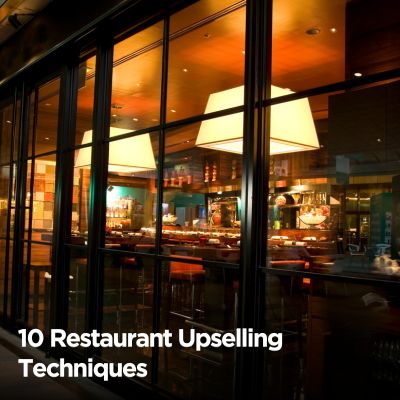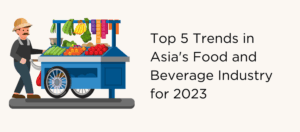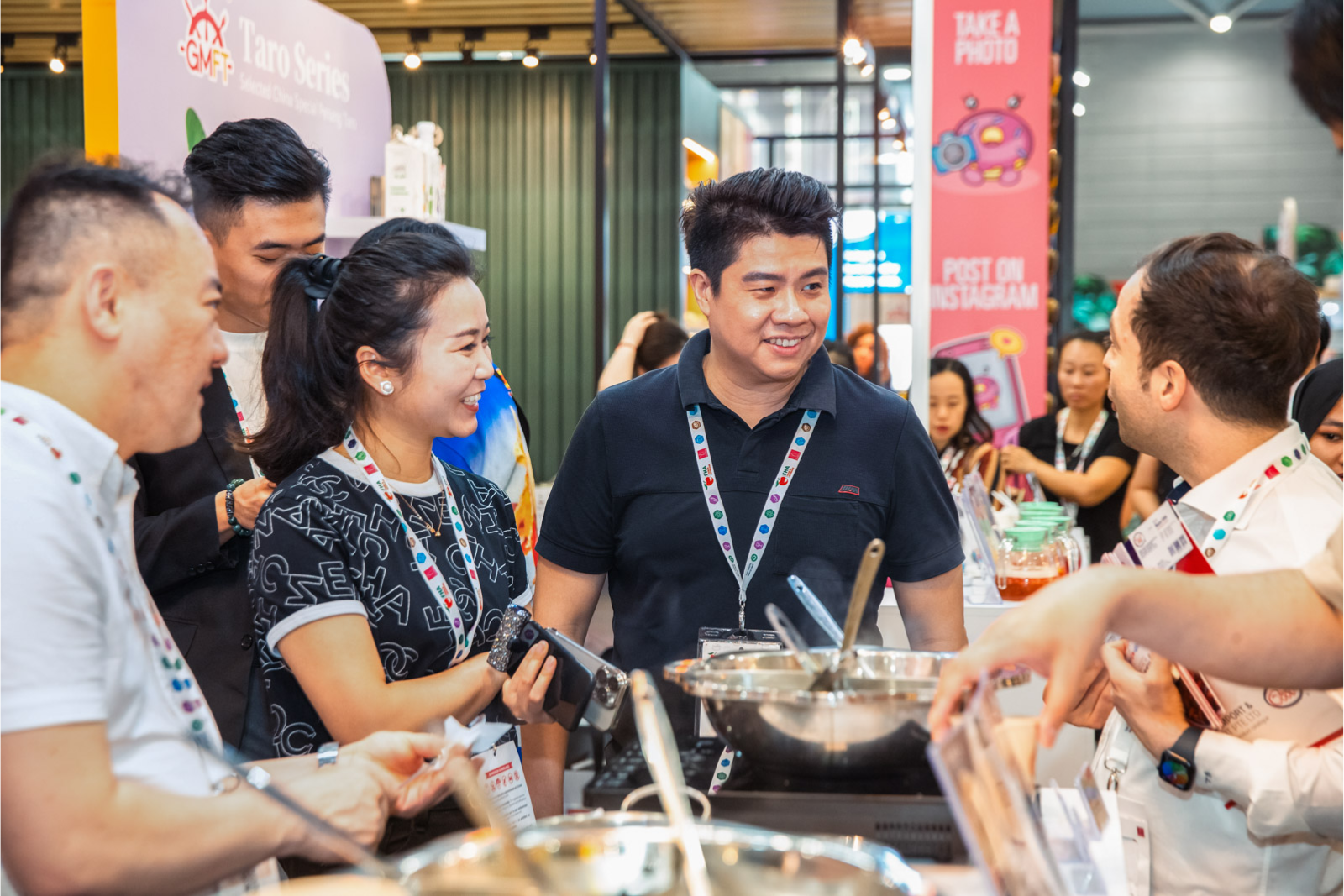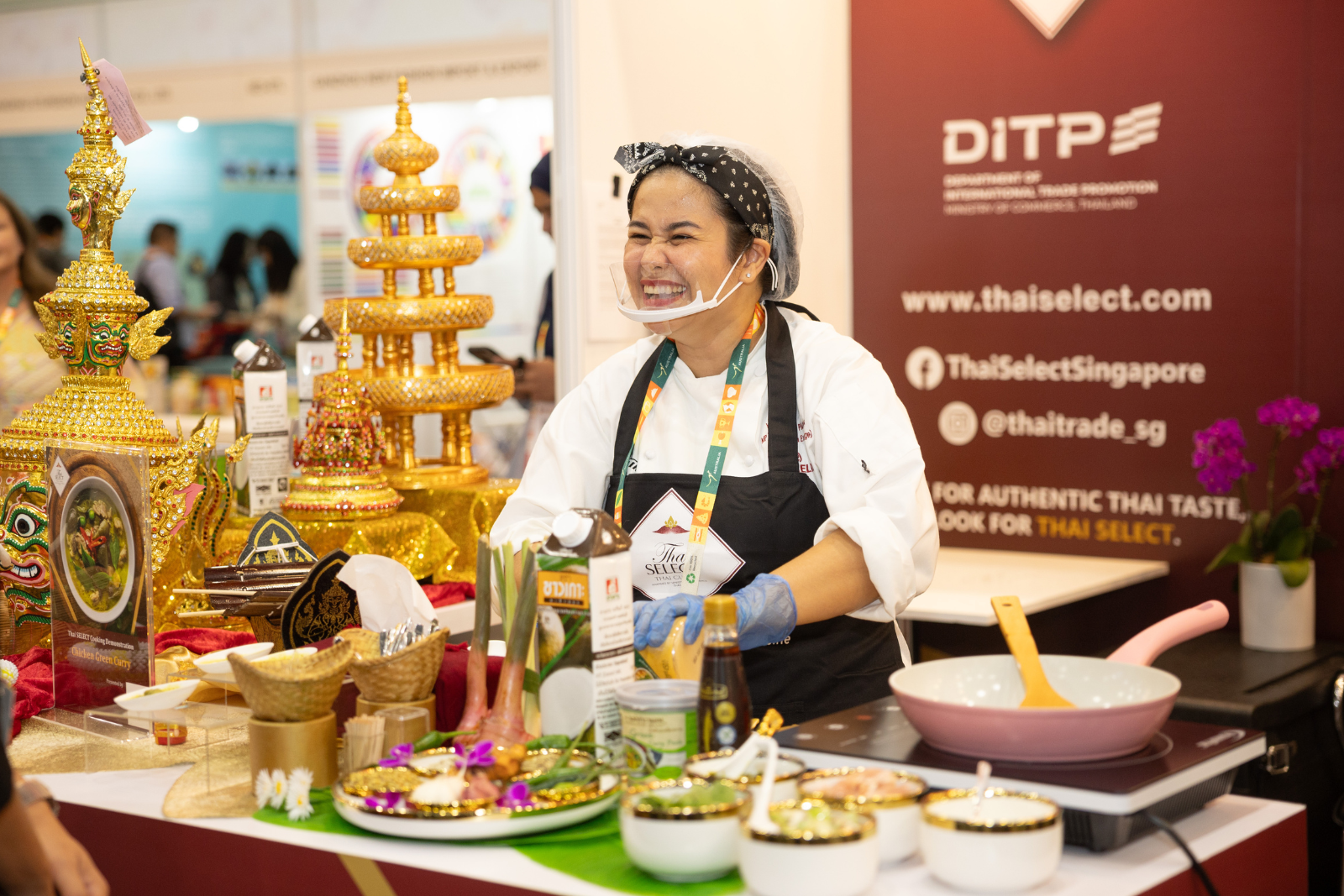Upselling is one of the most effective ways for restaurants to increase profits without changing the menu or raising prices. When used correctly, restaurant upselling techniques can improve the dining experience and the restaurant’s bottom line.
In a restaurant setting, upselling refers to suggesting additional items, upgrades, or combinations that enhance the customer’s meal. It is not about pushing unnecessary products but offering thoughtful recommendations that add value to the guest’s experience.
Whether suggesting a starter to complement the main course, recommending a premium wine pairing, or offering a special dessert, well-executed upselling feels natural and welcomed.
Successful upselling requires more than a friendly suggestion. It depends on staff training, timing, understanding customer preferences, and designing a menu that naturally leads customers toward higher-value choices.
When applied thoughtfully, these strategies can significantly increase average ticket size while strengthening customer satisfaction.
This blog will explain 10 actionable restaurant upselling techniques that can increase sales, improve the guest experience, and support the long-term success of your restaurant.
Why Upselling Matters for Restaurants
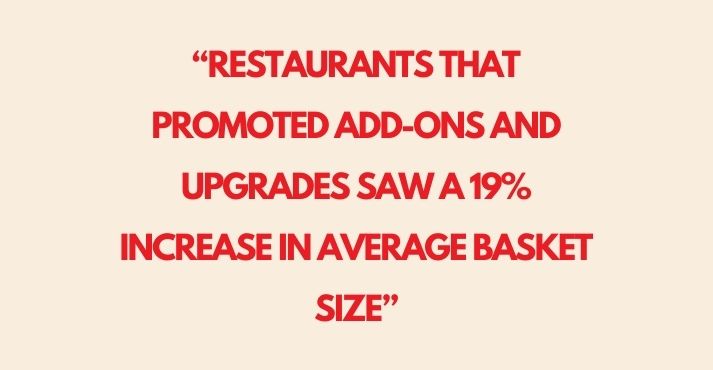
Upselling in restaurants is an important way to boost profits and improve the customer experience. When implemented thoughtfully, upselling strengthens the top line and the guest’s satisfaction, making it an essential focus for any full service restaurant.
Financially, upselling has a measurable impact. According to recent industry data, restaurants that actively promoted additional items and meal upgrades saw the average basket size increase by 19%, while online orders rose by 44%. These numbers show how menu upselling tactics can help increase revenue.
Beyond financial gains, upselling also enhances the guest experience. By recommending items that complement the customer’s preferences or highlight the chef’s specialties, servers can create a more personalized and memorable meal.
Guests often appreciate knowledgeable suggestions that enhance their dining experience, leading to greater satisfaction and repeat visits.
Upselling also benefits front-of-house and back-of-house operations. It offers servers an opportunity to boost tips through higher check averages. Strategic promotions can help manage inventory for the kitchen by steering guests toward high-margin or overstocked items.
When upselling is part of a well-coordinated service approach, it supports efficiency, profitability, and guest loyalty across the entire restaurant.
Top 10 Restaurant Upselling Techniques
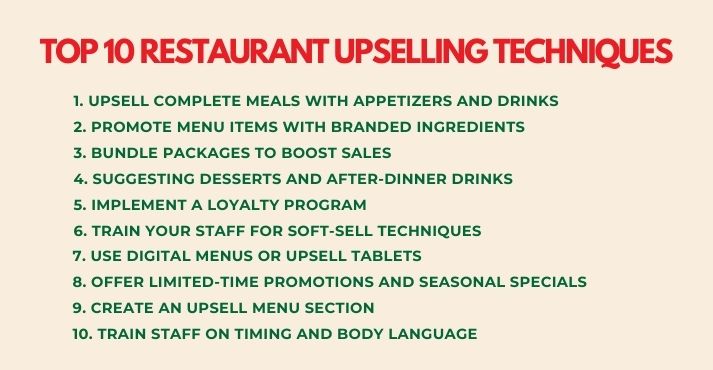
Strong upselling techniques help restaurants increase revenue, enhance the guest experience, and make service more efficient. By learning how to upsell menu items naturally and effectively, staff can improve restaurant operations without making guests feel pressured.
The following restaurant upsell strategies focus on practical, proven methods that are easy to train and apply:
1. Upsell Complete Meals with Appetizers and Drinks
One of the most effective ways to upsell menu items is by recommending complete meals. When servers suggest an entrée, an appetizer, and an alcoholic beverage, they create a more satisfying experience for the guest while boosting the check size.
Studies show that when guests order an entrée, appetizer, and alcoholic beverage, their total check is almost 47% higher than usual.
To make upselling feel natural, staff should be trained to offer suggestions based on the customer’s preferences.
For example, if a guest orders a steak, the server can recommend a starter that complements the meal, like a light salad, and suggest a wine pairing to enhance the flavors. Subtle, thoughtful recommendations build trust and make guests more open to additional purchases.
Practical tips for training servers include teaching them to ask open-ended questions like, “Would you like to start with one of our chef’s appetizers?” or “Can I recommend a drink that pairs really well with your entrée?”
2. Promote Menu Items with Branded Ingredients
Highlighting premium dishes made with branded ingredients is another smart restaurant upsell strategy. Branded products are often linked to better quality, and many customers associate them with a superior dining experience.
When upselling, servers should point out the quality of branded items naturally. For example, they can mention that a burger is made with a well-known premium cheese or that a dessert features a specialty chocolate brand.
Emphasizing these details makes dishes more appealing and helps justify a higher price. Training should focus on helping staff learn which branded ingredients are used on the menu and how to highlight them casually during conversations, rather than using a sales pitch.
3. Bundle Packages to Boost Sales
Bundling is one of the best restaurant marketing strategies for increasing the average check size. Offering a complete package, like a three-course meal or a special drink and dessert combo, encourages guests to buy more items together.
Bundled packages have been shown to increase check size by making it easier for guests to choose more items at once.
To upsell menu items effectively through bundling, staff should introduce packages when taking the initial order or discussing the main course. Timing is important to make the offer feel like a natural part of the dining experience.
Successful examples include prix fixe menus that bundle an appetizer, entrée, and dessert at a value price or limited-time promotions that add a specialty cocktail to the meal for a small upgrade.
Teaching staff how and when to suggest bundles supports smoother restaurant operations and creates a better dining experience for guests.
4. Suggesting Desserts and After-Dinner Drinks
Tempting guests with dessert options and after-dinner drinks is a proven way to boost restaurant profits. Desserts and coffee or liqueur drinks are often seen as indulgent, and many guests are willing to treat themselves after a satisfying meal.
Timing is essential here; servers should wait until after the main course has been cleared before suggesting these items, ensuring guests are still in the mood to enjoy a sweet or relaxing drink.
To integrate these promotions seamlessly into the server’s routine, suggest offering one or two signature desserts and after-dinner drink options that pair well with the main courses.
Training staff to present these items casually — perhaps with a “Would you like to finish your meal with something sweet?” — helps avoid pushing, keeping the atmosphere friendly and inviting.
Using restaurant technology, like a tablet with a dessert menu that can be easily shared, can also increase awareness of these high-margin items and help increase restaurant revenue.
5. Implement a Loyalty Program
Loyalty programs are a powerful restaurant strategy to increase repeat business and revenue. By offering guests rewards for spending more, restaurants incentivize higher ticket sales and create a sense of value that keeps customers returning.
Research shows that restaurants with loyalty programs see visits and spending increase by 18–30%, proving their effectiveness in driving customer satisfaction and business growth.
To create an effective loyalty program, tie rewards to higher spending amounts. For example, after a guest spends a certain amount, they could earn points that lead to a free appetizer or a discount on a future visit.
Integrating these rewards with upselling strategies, like offering bonus points for premium dishes or drinks, creates a seamless experience that encourages guests to spend more while feeling appreciated.
6. Train Your Staff for Soft-Sell Techniques
Proper training in upselling techniques can significantly impact restaurant operations and overall sales. Soft-sell techniques, such as suggesting premium menu items with a casual tone, allow servers to recommend upsells without feeling pushy.
For example, instead of saying, “You should try this expensive wine,” a server might say, “This wine pairs beautifully with your dish and would complement the flavors perfectly.” This approach boosts customer experience while encouraging higher spending.
To make this effective, offer training tips and practice scripts that emphasize the subtlety of the soft-sell approach.
Role-playing during staff meetings can help servers feel more confident suggesting items like desserts, drinks, and upsells in a friendly manner, rather than in a hard-sell tone.
In the long run, it’s about helping staff increase restaurant revenue while maintaining customer satisfaction and trust.
7. Use Digital Menus or Upsell Tablets
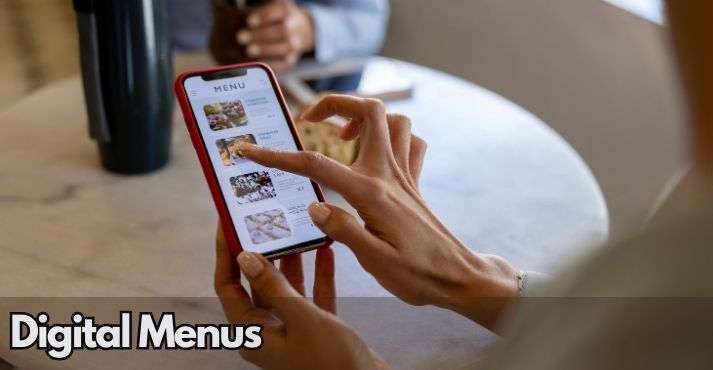
Digital menus and upsell tablets effectively promote premium items, pairings, and specials. These menus encourage customers to consider higher-ticket items by incorporating high-quality images and enticing descriptions.
Customers are more likely to splurge on premium choices when visually appealing items are described with attention to detail.
Integrating upsell prompts into digital ordering systems is an effective upselling method. For instance, if a customer orders a main dish, the system can automatically suggest a wine pairing or a side dish to enhance the experience.
This seamless integration helps increase restaurant sales while ensuring a smooth customer experience, tapping into the growing technology in the restaurant industry.
8. Offer Limited-Time Promotions and Seasonal Specials
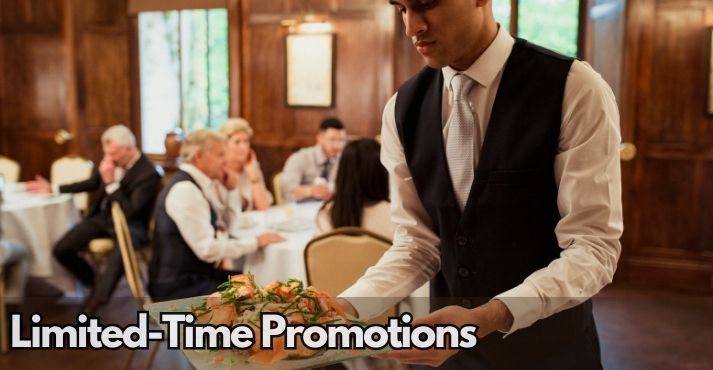
Creating a sense of urgency around special offers can significantly increase sales. Limited-time promotions (LTOs) create a fear of missing out (FOMO), prompting customers to take advantage of offers before they’re gone.
Research shows that LTOs can boost sales by up to 20% during promotional periods, making them an effective strategy for driving traffic and higher check sizes.
Seasonal specials, such as a winter-inspired soup or a summer seafood platter, also provide excellent opportunities for upselling.
Offering these dishes with a limited-time appeal creates excitement and encourages customers to add them to their orders. When framed as a must-try, they can increase food and drink upselling.
9. Create an Upsell Menu Section
Designing a dedicated section on the menu for recommended, high-margin items can significantly influence customer choices.
Menu sections featuring high-margin items can result in a 10% increase in sales, showing how strategic menu placement can drive higher ticket totals. These sections could feature premium appetizers, signature drinks, or chef’s specials with the best profit margins.
To ensure success, it’s essential to position these items effectively within the menu layout. Placing them near the top or in visually appealing sections encourages customers to consider these items first, especially when highlighted as the “chef’s recommendation” or “today’s special.”
10. Train Staff on Timing and Body Language
The timing of upselling can make a significant difference in restaurant sales strategies. Offering upsells at the right moment, typically after the meal is served but before the check arrives, can boost check sizes by 10-15%.
Knowing when to suggest additional items, such as a dessert or an after-dinner drink, ensures the offer is not intrusive or forced.
Training staff to be mindful of body language is also essential in making upselling feel natural. Positive, welcoming body language encourages customers to respond favorably to upsell suggestions.
For example, leaning slightly toward the customer while suggesting can convey genuine interest in enhancing their dining experience, leading to more successful food service and hospitality interactions.
Conclusion
The 10 restaurant upselling techniques outlined above provide a roadmap to boost revenue while enhancing the customer experience.
By recommending complete meals, highlighting premium ingredients, offering bundled packages, and using digital tools, restaurants can create an environment that encourages guests to spend more, without feeling pressured.
When done correctly, upselling increases check sizes and improves customer satisfaction by offering personalized, thoughtful recommendations.
Start by choosing a few strategies that align with your restaurant’s style, and track the results to see what works best. With consistent practice and staff training, these upselling methods can become a powerful part of your restaurant’s growth strategy.
By implementing these techniques, you’ll see the impact on your revenue and guests’ dining experience.

